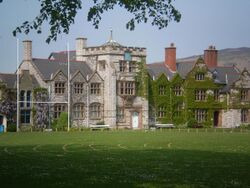Ruthin School
Topic: Organization
 From HandWiki - Reading time: 7 min
From HandWiki - Reading time: 7 min
| Ruthin School | |
|---|---|
 | |
 Ruthin School's main building, opened in 1893 | |
| Address | |
| Lua error in Module:Mapframe at line 384: attempt to perform arithmetic on local 'lat_d' (a nil value). | |
Mold Road Ruthin , Denbighshire , LL15 1EE Wales | |
| Coordinates | [ ⚑ ] : 53°07′02″N 3°17′59″W / 53.1171°N 3.2997°W |
| Information | |
| Type | Private day & boarding |
| Motto | Dei Gratia Sum Quod Sum English translation: By the Grace of God I am What I am |
| Established | c. 1284 |
| Gender | Coeducational |
| Age | 11 to 18 |
| Visitor | HM Queen Elizabeth II |
| Website | http://www.ruthinschool.co.uk |
Ruthin School is a private day and boarding school located on the outskirts of Ruthin, the county town of Denbighshire, North Wales. It is over seven hundred years old, making it one of the oldest schools in the United Kingdom. Originally a school for boys, it has been co-educational since 1990.
Education
In the 2013 A Level results, 60.23% of grades attained by students at the school were A* or A. This figure was increased in 2016 to 76%, as well as a pass rate of 100%.[1] 90% of 2017 university applications at the school were to Russell Group or top 20 universities.[2] In 2017 the school had the 27th best A-level results of British independent schools.[3]
The school won the 2016, 2017 and 2018 UKMT national mathematics competitions, resulting in their selection to represent the United Kingdom in Europe for three consecutive years. The school won the national Chemistry Analyst Competition in 2015, and has had gold award winning pupils in Olympiads for Mathematics, Physics and Chemistry every year in recent times.[4][5][6][non-primary source needed]
According to the 2014 Estyn inspection report, English and mathematics at key stage four are well above Wales' average, and percentage of year 11 students achieving the level 2 threshold is also above the Welsh average. A* to C grades awarded for GCSE entries has improved and increased steadily for the past few years. Sixth Form students are at well above the Wales average at level 3, achieving good results in their A levels.[7]
History
Beginnings
Ruthin School was founded in the wake of Edward I's conquest of Wales. Whilst the precise date of the foundation is not certain, Keith Thompson argues in his history of the school that 1284 is the most likely date and Reginald de Grey the most likely founder. In any event, it is clear from the Taxatio Ecclesiastica of 1291 that a collegiate church and school existed at Ruthin by that date.
Evidence of Ruthin School in the subsequent centuries is sparse. Surviving documents such as a Confirmatio of 1314/1315 which recognised the existence, rights and liberties of "collegio de Ruthin fundato per Reginald de Grey" indicate the existence of the School but nothing more is known of the size of the establishment.
Following Owain Glyndŵr's attack on Ruthin in September 1400, it appears that the collegiate church, and presumably also the school, continued to function unscathed until the dissolution of the former in 1535. Evidence for the school's continuation over the following decades is sketchy, but it is known that in 1561 the tithes of the sinecure of Llanelidan were applied to the use of the school, which suggests that pupils at that time would have been from local homes.
Re-foundation
In 1574, Gabriel Goodman, the Dean of Westminster and an Old Ruthinian, built a two-storey, limestone building to house the school in the shadow of the Church. The school appears to have prospered, and in 1595 Dean Goodman successfully petitioned Queen Elizabeth I to grant the tithes of Llanelidan to the school in perpetuity.
Following its refoundation, the grammar school educated the sons of local gentry, including the Grosvenor, Kenyon and Trevor families. Former pupils included Lloyd Kenyon, 1st Baron Kenyon and Sir John Trevor sometime Master of the Rolls and Speaker of the Speaker of the House of Commons.
Relocation and twentieth-century
In 1893 the school moved from the immediate vicinity of the church to a building designed by John Douglas on its site on the eastern outskirts of the town. In 1923 Lord Kenyon opened the Memorial Cricket Pavilion to honour those Old Ruthinians who had died during the First World War.
As the century progressed, the demand for places increased, and in 1949 Bishop Wynne House was inaugurated. Just over a decade later, a new school hall comprising a refectory, kitchens, classrooms, and a theatre were constructed.
Expansion continued, and in 1971 a preparatory department was established in the former Archbishop Williams' house. The quatercentenary of the School's re-foundation was commemorated by the launch of plans for the construction of a new wing consisting of dormitories, a music room, classrooms, locker rooms and other facilities, plans which culminated in 1980.
The School's septcentenary was commemorated by a visit of Her Majesty Queen Elizabeth II, the School's Visitor, and His Royal Highness the Duke of Edinburgh on 16 March 1984 when a clock in the central tower was unveiled.
Twenty-first century
On the hundredth anniversary of the school's relocation, the Hall was further extended and in 2006 the Hewer Hall, a sports facility, was opened by The Princess Royal.
The then Principal, Toby Belfield, caused controversy in May 2015 when he questioned the merits of a bilingual education in a letter to the Denbighshire Free Press, acknowledging that "tradition and heritage are important – but much more important is to ensure that we do not reduce the opportunities available for Welsh children." His claims that bilingual education was educationally "weaker" than in England and abroad received widespread attention nationally, splitting opinion.[citation needed] The school attracted national attention again in February 2017, after leaked emails from the Principal (addressed to the students and parents) concerning a crackdown on behaviour caused controversy.[8] The principal stated that he wished to expel students who engaged in romantic relationships and/or give them inferior references for university admissions, stating that he would "always" "definitely" give a worse reference; and that he would "not hesitate" to expel students who engaged in sexual activity.[9] After the e-mails were released, Belfield released a contradictory statement that if the student was making high marks, he would not reduce the quality of his or her recommendations even if he or she was dating.[8]
In an ironic twist, it was discovered Belfield was trying to engage in relationships with several students after hundreds of sexualised text messages that he had sent to the school's female pupils emerged. He complimented his students 'breasts' and asked about their 'virginities', as well as boasting about how he used to meet students abroad.[10] The girls ages ranged from 15 to 18. The extent of Belfield's grooming is still unknown, yet it is understood he sought to remain in contact with several female students after they had left school. Belfield was placed on leave at the end of 2019; he had already been suspended following an earlier investigation two years prior, but allowed to return to work.[10]
In January 2020, following an unannounced inspection, Care Inspectorate Wales, which oversees the welfare and safeguarding of children, published a damning report on "inadequate" policies and procedures that are in breach of discrimination and human rights laws, stating "serious shortfalls" meant pupils are "not appropriately safeguarded" and "at risk of harm".[11][12][13]
Traditions
Church services
The school traditionally travels to the Collegiate and Parochial Church of St Peter three times annually: once to mark Remembrance Day, once for a Christmas Carol Service, and once for Founder's Day.[14]
Hill fort run
In the summer term there is an annual race from school to the summit of Moel Fenlli and back down again – a 7.5-mile (12.1 km) cross-country race in which school students and staff compete.[15] The prize for the winner is a pot of marmalade, with trophies for the first boy and girl finishing in each age group.[16]
Sovereign's visitatorial rights
The monarch is the visitor of Ruthin School, whose rights have traditionally been exercised by the Lord Lieutenant.
Old Ruthinian Association
The Old Ruthinian Association consists of former pupils of Ruthin School. The Association was founded after the First World War and gathers for its annual meeting on the Saturday of Remembrance Weekend at Ruthin Castle.
Distinguished Old Ruthinians
- (1568) Richard Parry: Bishop of St Asaph, translator of the Welsh Bible
- (1589) Godfrey Goodman: Bishop of Gloucester
- (1590) John Williams: Dean of Westminster, Bishop of Lincoln, Lord Keeper of the Great Seal of England, Archbishop of York
- (1640) William Lloyd: Bishop of Llandaff; Bishop of Peterborough; Bishop of Norwich
- (1645) Sir John Trevor: Master of the Rolls; Speaker of the House of Commons; knight
- (1650) Thomas Lloyd: Deputy Governor of Pennsylvania
- (1675) John Wynne: Bishop of St Asaph; Bishop of Bath & Wells
- (c.1709) Sir Watkin Williams-Wynn, 3rd Baronet and 'Prince of Wales' (1693–1749) [in Peter DG Thomas' Politics in Eighteenth Century Wales (1998)]
- (1722) Josiah Tucker: Dean of Gloucester
- (1733) Richard Perryn: Baron of the Exchequer
- (1744) Lloyd Kenyon, 1st Baron Kenyon: Master of the Rolls; Lord Chief Justice of England
- (1851) Rowland Ellis: Bishop of Aberdeen and Orkney
- (1860) Elias Owen; Welsh international footballer[17]
- (1886) Sir Lewis Casson: M.C.; actor and producer; knight
- (1935) Sir Ian Richmond: LL.D., F.S.A., F.B.A., Professor of Archaeology, University of Oxford; Fellow of All Souls; knight
- (1951) Neil Vernon-Roberts: Kenyan sports shooter
- (1954) Bob Barber: M.A., M.B.A., Test cricketer, captain of Lancashire and Warwickshire County Cricket Clubs
- (1964) Mike Roberts: Welsh international rugby union player
- (1980) Julian Lennon: Musician, photographer, and philanthropist
See also
- List of the oldest schools in the United Kingdom
- List of non-ecclesiastical and non-residential works by John Douglas
References
- ↑ "A Level and AS Level Results 2016". 20 August 2016. https://www.ruthinschool.co.uk/news/a-level-results-2016/.
- ↑ "School Information". https://www.ruthinschool.co.uk/school-information/.
- ↑ "Top 100 Independent Schools by A Levels and Pre U". https://www.best-schools.co.uk/uk-school-league-tables/list-of-league-tables/top-100-schools-by-a-level.
- ↑ "Perfect score wins national maths challenge for second year". 18 February 2016. https://ie-today.co.uk/dashboard2/news/perfect-score-wins-national-maths-challenge-for-second-year/.
- ↑ "Mathematics – UK National Champions – AGAIN!!!". 7 February 2018. https://www.ruthinschool.co.uk/news/mathematics-uk-national-champions/.
- ↑ @UKMathsTrust (7 February 2017). "Congratulations to Ruthin School, the winners of the Senior Team Maths Challenge 2017!". https://twitter.com/UKMathsTrust/status/829007714948882432.
- ↑ Estyn Inspection Report; accessed 11/06/2014
- ↑ 8.0 8.1 Ritschel, Chelsea (2 January 2018). "Public school headmaster backtracks threats of expulsion for pupils found in relationships". The Independent. https://www.independent.co.uk/life-style/public-school-headmaster-ruthin-school-pupil-relationships-expelled-north-wales-co-educational-a8174711.html. Retrieved 24 January 2018.
- ↑ Turner, Camilla (2 January 2018). "Headteacher of leading public school says he will expel pupils who have a boyfriend or girlfriend". The Daily Telegraph. https://www.telegraph.co.uk/education/2018/01/23/headteacher-leading-public-school-says-will-expel-pupils-have/. Retrieved 24 January 2018.
- ↑ 10.0 10.1 "Strict head sent flirtatious messages to 'naughty' girls". The Times. 2 January 2020. https://www.thetimes.co.uk/article/strict-head-sent-flirtatious-messages-to-naughty-girls-h52xj28ql.
- ↑ "Damning report finds 'serious shortfalls' at Ruthin boarding school with pupils 'at risk of harm'". ITV News. 2 January 2020. https://www.itv.com/news/wales/2020-01-20/damning-report-finds-serious-shortfalls-at-ruthin-boarding-school-with-pupils-at-risk-of-harm/.
- ↑ "Ruthin School pupils 'at risk of harm' says damning care watchdog report". North Wales Live. 2 January 2020. https://www.dailypost.co.uk/news/north-wales-news/ruthin-school-pupils-at-risk-17597798.
- ↑ "Top Ruthin school slammed in care report". Denbighshire Free Press. 2 January 2020. https://www.denbighshirefreepress.co.uk/news/18176210.top-school-slammed-care-report/.
- ↑ "Categories". https://www.ruthinschool.co.uk/events/categories/.
- ↑ "Hill-fort Run 2009". 23 June 2009. https://www.ruthinschool.co.uk/news/hill-fort-run-2009/.
- ↑ "Hill Fort Run". https://www.ruthinschool.co.uk/school-information/extra-curricular/hill-fort-run/.
- ↑ Cholerton, Moira. "Elias Owen (son of Elias)". Owen children. http://www.owen.cholerton.org/05_elias_52.php. Retrieved 3 December 2011.
Further reading
- Thompson, Keith M. (1974). Ruthin School: the first seven centuries. Ruthin: Ruthin School Quatercentenary Committee. ISBN 0950387304.
External links
- School website
- Old Ruthinian Association website
- Profile on the Independent Schools Council website
 |
 KSF
KSF
